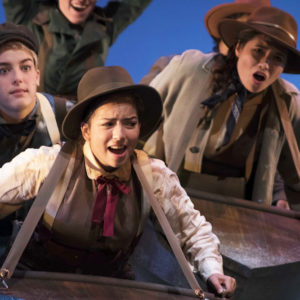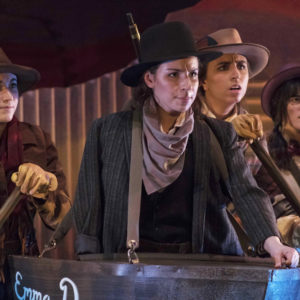
Stage lights slowly illuminated Keck Theater at 7:30 p.m. Nov. 7, the opening night of the Occidental theater department’s play “Men on Boats.” Beneath the corrugated texture and sunset-like colors of set pieces representing the walls of the Grand Canyon, the play’s cast of 10 plunged into a dynamic performance. Wearing costumes shaped like half-boats, they called out to one another as they spun and rocked across the stage, mimicking the motion of river rapids. The show ran three 7:30 p.m. performances Nov. 7–9 and one 2 p.m. matinee Nov. 10, according to director Deena Selenow. Selenow is Occidental’s Wanlass artist-in-residence, meaning the theater department has invited her to teach a class in Spring 2020 in addition to directing “Men on Boats.”
Though it depicts John Wesley Powell and his crew of men on an expedition through the Grand Canyon in 1869, “Men on Boats” was originally written to be performed only by female and nonbinary performers, according to Selenow. She said she chose it not only because she went to college with the playwright, Jaclyn Backhaus, but because it would give female and nonbinary performers in Occidental’s theater department an opportunity to play complex, challenging roles. It would also allow them to reclaim a history that had excluded them.
“Where are the new classics? Who are the playwrights writing the new classics? What’s the new canon?” Selenow said. “Tennessee Williams is a phenomenal playwright, but he didn’t write plays that told my story. And that’s okay — there’s nothing wrong with that — but then where are other stories? There’s room for all of us.”
Naya Ramtahal (sophomore), who played the crew’s cook, Hawkins, said she saw the performance as a new take on history rather than an exact recreation.
“Nobody’s binding their chest to look like a guy or having facial hair or anything,” Ramtahal said. “These are characters, and I’m not going to try and conflate them with the historical figures that they were because, I’m gonna be real with you, I’m pretty sure that all of those men were horrible people.”

Ramtahal said she appreciated Selenow’s collaborative directing style as well as the play she chose. According to Ramtahal, diverse representation is as necessary within Occidental itself as it is within the general world of theater.
“The theater department is a very white department,” Ramtahal said. “[It was] important to have a woman of color who was taking a script that is trying to break the norms of representation in theater.”
Selenow said theater department chair Susan Gratch invited her to Occidental in the spring, and she chose to direct “Men on Boats” shortly afterward. Production began on the scenery during the summer, and Selenow held auditions in September. Once selected, actors read through and discussed the script in a weeklong process called “table work.”
Then they got on their feet. According to Selenow, guest choreographer Diana Wyenn — who also attended college with Selenow — guided the actors through two weeks of “movement boot camp,” where they learned to move as though riding the rough river. A voice workshop with guest vocal coach Kalean Ung followed.
According to Ramtahal, the gender-bending casting taught the actors how to take up space on stage. When she first read the script, Ramtahal said, she was not sure what direction to take her character in. But then inspiration struck: Hawkins was a f*ckboy.
“It’s usually a little more difficult for a woman to socially act like that. I feel like there’s just a lot more freedom [in the play]. I also think it’s an aspect of making fun of popular guy culture,” Ramtahal said. “When you’re looking at comedy and what you make fun of, you go for the people who are on the top.”

Allie Frank (senior) played Powell, the expedition’s leader. Powell is an overly optimistic character, Frank said, and his refusal to give up on his mission begins to cause conflict when it puts other characters in danger. Because the real Powell had one arm, Frank had to learn to act with one arm, too, which she said was challenging in such a physical production.
“Deena will direct me like, ‘No, be center for that,’ or ‘No, take up more space,’ or ‘No, push him out of the way.’ And I’m like, ‘Oh, but that’s rude! I am a lady — I couldn’t possibly!'” Frank said. “The phrase that she uses is, ‘Pee all over everything!’ She said that to us several times.”
Frank, a theater and computer science double major, said acting in “Men on Boats” is part of her theater senior comprehensive project (comps). She will write a paper on the process in the spring.
According to Gratch, stage manager Mitchell Carswell (senior) and scenic designer Zoë Speer (senior) also worked on “Men on Boats” in fulfillment of their comps. Gratch, whose background is in scenic and lighting design, said she mentored Speer during the process: they met each step of the way to discuss Speer’s ideas and figure out how to align them with Selenow’s vision. Gratch said she typically mentors at least one student a year.
Speer began researching during the summer. She studied photos from Powell’s expedition and art depicting the Grand Canyon; one painting by Glen S. Hopkinson, she said, was particularly inspiring because of its deep colors and impressionistic style. On her way to LA from Tennessee, she even stopped to see the real Grand Canyon. According to Speer, a major question on her mind during the research process was whether to make the set look realistic or idealized.
“I think our production leans more towards the stylized idea of it,” Speer said. “It works great because the show is not trying to be exact — they use contemporary language even though it happened in 1869.”
Speer then built a small model of her vision, and Selenow loved the texture of the corrugated cardboard Speer used. But the ridges of real cardboard wouldn’t have been visible onstage, so Speer had to scale it up and create exact blueprints for the shop to build. She painted the set pieces herself.
Nick Reulbach (first year), who attended the opening night of “Men on Boats” to see Ramtahal and other friends perform, said the technical aspect of the show was his favorite part.
“It put a mood and set the tone for the scene,” Reulbach said. “I’m definitely not using the most technical terms — my professor would be very upset with me — [but] it was not necessarily just a physical experience. You could feel what was happening instead of just seeing and hearing.”
In the final scene of “Men on Boats,” the exhausted characters complete their expedition having lost a boat, a few men and most of their food. They encounter the unhelpful Mr. Asa, played by Natalya Nielsen (junior), who fantasizes about using the crew to make himself famous. As the lights faded on opening night, Nielsen gazed into the audience.
“You were alive, I’ll say,” Nielsen said as Asa. “And this was your story.”
This article was corrected Nov. 13, 2019 at 1:20 p.m. to reflect the number of actors in the cast.
![]()


































